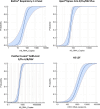Enhancing diagnostic preparedness for H5N1: a validation study of H5 single-plex assay and detection across multiple platforms
- PMID: 40679852
- PMCID: PMC12345207
- DOI: 10.1128/jcm.00681-25
Enhancing diagnostic preparedness for H5N1: a validation study of H5 single-plex assay and detection across multiple platforms
Abstract
The increasing transmission of highly pathogenic avian influenza (HPAI) H5N1 from animals to humans underscores the urgent need for enhanced diagnostic capabilities in clinical microbiology laboratories. Although in silico analysis suggests that commercial multiplex respiratory panels can detect H5N1, these assays lack subtyping H5N1 capabilities, and their real-world performance remains largely unverified. In this study, we evaluated the limit of detection (LoD) for H5N1 using three commercial molecular diagnostic assays routinely employed at our institution: bioMérieux BioFire Respiratory 2.1 Panel, Cepheid Xpert Xpress CoV-2/Flu/RSV Plus, and Hologic Panther Fusion SARS-CoV-2/Flu A/B/RSV assays. All three reliably detected H5N1 were at low viral concentrations. To enable H5N1 detection, we also developed a real-time RT-PCR H5 single-plex assay on the Hologic Panther Fusion Open Access platform for reflex testing of influenza A-positive specimens. In conclusion, although current commercial assays lack influenza A H5 subtype differentiation, our validation data provide critical performance information. When integrated with a targeted H5 assay, these tools can enhance clinical decision-making and public health surveillance by reducing the risk of missed H5N1 infection cases.IMPORTANCEThis study addresses a growing public health concern: the spread of bird flu (H5N1) from animals to humans. Most hospital laboratories use commercial tests to detect respiratory viruses like the flu, but these tests cannot tell if someone has the specific and more dangerous H5N1 strain. To help solve this, we tested three commonly used diagnostic tools and found that they can detect H5N1 even at low levels. However, since they cannot identify the specific H5 subtype, we also developed and validated a follow-up test that runs on one of the existing laboratory high-throughput equipment. This test can confirm whether a patient infected with the flu has the H5N1 strain. By combining these tools, hospital laboratories can improve early detection of H5N1, support better patient care, and help public health officials respond more effectively to outbreaks.
Keywords: Clade 2.3.4.4b; H5N1; LDT; LoD.
Conflict of interest statement
The authors declare no conflict of interest.
Figures

Similar articles
-
Toward diagnostic preparedness: detection of highly pathogenic avian influenza A(H5N1) in contrived nasal swab specimens using rapid antigen and point-of-care molecular tests.J Clin Microbiol. 2025 Aug 19:e0054825. doi: 10.1128/jcm.00548-25. Online ahead of print. J Clin Microbiol. 2025. PMID: 40827905
-
Novel (d)PCR assays for influenza A(H5Nx) viruses clade 2.3.4.4b surveillance.Euro Surveill. 2025 Aug;30(33):2500183. doi: 10.2807/1560-7917.ES.2025.30.33.2500183. Euro Surveill. 2025. PMID: 40843521 Free PMC article.
-
Molecular Detection of Various Non-Seasonal, Zoonotic Influenza Viruses Using BioFire FilmArray and GenXpert Diagnostic Platforms.Viruses. 2025 Jul 10;17(7):970. doi: 10.3390/v17070970. Viruses. 2025. PMID: 40733587 Free PMC article.
-
Laboratory-based molecular test alternatives to RT-PCR for the diagnosis of SARS-CoV-2 infection.Cochrane Database Syst Rev. 2024 Oct 14;10(10):CD015618. doi: 10.1002/14651858.CD015618. Cochrane Database Syst Rev. 2024. PMID: 39400904
-
Rapid, point-of-care antigen tests for diagnosis of SARS-CoV-2 infection.Cochrane Database Syst Rev. 2022 Jul 22;7(7):CD013705. doi: 10.1002/14651858.CD013705.pub3. Cochrane Database Syst Rev. 2022. PMID: 35866452 Free PMC article.
References
-
- Blagodatski A, Trutneva K, Glazova O, Mityaeva O, Shevkova L, Kegeles E, Onyanov N, Fede K, Maznina A, Khavina E, Yeo SJ, Park H, Volchkov P. 2021. Avian influenza in wild birds and poultry: dissemination pathways, monitoring methods, and virus ecology. Pathogens 10:630. doi: 10.3390/pathogens10050630 - DOI - PMC - PubMed
-
- Welsh Caitlin SZ. 2025. How is bird flu impacting agriculture and food security in the United States?, On Center for Strategic and International Studies. Available from: https://www.csis.org/analysis/how-bird-flu-impacting-agriculture-and-foo...
-
- Uhart MM, Vanstreels RET, Nelson MI, Olivera V, Campagna J, Zavattieri V, Lemey P, Campagna C, Falabella V, Rimondi A. 2024. Epidemiological data of an influenza A/H5N1 outbreak in elephant seals in Argentina indicates mammal-to-mammal transmission. Nat Commun 15:9516. doi: 10.1038/s41467-024-53766-5 - DOI - PMC - PubMed
-
- Tomás G, Marandino A, Panzera Y, Rodríguez S, Wallau GL, Dezordi FZ, Pérez R, Bassetti L, Negro R, Williman J, Uriarte V, Grazioli F, Leizagoyen C, Riverón S, Coronel J, Bello S, Páez E, Lima M, Méndez V, Pérez R. 2024. Highly pathogenic avian influenza H5N1 virus infections in pinnipeds and seabirds in Uruguay: implications for bird-mammal transmission in South America. Virus Evol 10:veae031. doi: 10.1093/ve/veae031 - DOI - PMC - PubMed
Publication types
MeSH terms
LinkOut - more resources
Full Text Sources
Medical
Miscellaneous

